U n i v e r s i t é Y O R K U n i v e r s i t y
ATKINSON FACULTY OF LIBERAL AND PROFESSIONAL STUDIES
SCHOOL OF ANALYTIC STUDIES & INFORMATION TECHNOLOGY
S C I E N C E A N D T E C H N O L O G Y S T U D I E S
STS 3700B 6.0 HISTORY OF COMPUTING AND INFORMATION TECHNOLOGY
ATKINSON FACULTY OF LIBERAL AND PROFESSIONAL STUDIES
SCHOOL OF ANALYTIC STUDIES & INFORMATION TECHNOLOGY
S C I E N C E A N D T E C H N O L O G Y S T U D I E S
STS 3700B 6.0 HISTORY OF COMPUTING AND INFORMATION TECHNOLOGY
Lecture 15: Towards the First Modern Computers
| Prev | Next | Search | Syllabus | Selected References | Home |
| 0 | 1 | 2 | 3 | 4 | 5 | 6 | 7 | 8 | 9 | 10 | 11 | 12 | 13 | 14 | 15 | 16 | 17 | 18 | 19 | 20 | 21 | 22 |
Topics
-
"There ought to be some mechanical way of doing this job, something on the principle of the Jacquard loom, whereby holes in a card regulate the pattern to be woven."
Herman Hollerith - Before surveying the events of the first half of the twentieth century, I want to tidy up a few loose ends in the nineteenth century. While it is true that Babbage's engines represent the only true major innovation in this period, a few other machines were introduced which, while not particularly innovative in design, had the important benefit of being strong and durable, and became well established in business applications. For example, in 1820 Charles Xavier Thomas de Colmar (1785-1870) manufactures his Arithmometer, the first mass-produced calculator. "It does multiplication using the same general approach as Leibniz's calculator [ see Lecture 10 ]; with assistance from the user it can also do division. It is also the most reliable calculator yet. Machines of this general design, large enough to occupy most of a desktop, continue to be sold for about 90 years." [ see The History of Computing Project ] "In 1834 George Scheutz, of Stockholm, produces a small difference engine in wood, after reading a brief description of Babbage's project" and "in 1843 Scheutz and his son Edvard Scheutz produce a 3rd-order difference engine with printer, and the Swedish government agrees to fund their next development. In 1853 to Babbage's delight, the Scheutzes complete the first full-scale difference engine, which they call a Tabulating Machine. It operates on 15-digit numbers and 4th-order differences, and produces printed output as Babbage's would have. A second machine is later built to the same design by the firm of Bryan Donkin of London. In 1858 the first Tabulating Machine is bought by the Dudley Observatory in Albany, New York, and the second one by the British government. The Albany machine is used to produce a set of astronomical tables; but the observatory's director is then fired for this extravagant purchase, and the machine is never seriously used again, eventually ending up in a museum. (The second machine, however, will have a long and useful life.) In 1886 Dorr E Felt (1862-1930), of Chicago, makes his Comptometer. This is the first calculator where the operands are entered merely by pressing keys rather than having to be, for example, dialed in. It is feasible because of Felt's invention of a carry mechanism fast enough to act while the keys return from being pressed. Visit The Interactive Adding Machine, where you can play with an 1885 Felt & Tarrant Comptometer. In 1892 William S Burroughs (1857-98), of St. Louis, invents a machine similar to Felt's but more robust, and this is the one that really starts the office calculator industry." [ from A Chronology of Digital Computing Machines (to 1952) ]
-
The nineteenth century ended with a major invention by
 Herman Hollerith (1860 - 1929).
"It was in solving the problems of analysing the large amounts of data generated by the 1880 US census that Hollerith was led
to look for ways of manipulating data mechanically."
Herman Hollerith (1860 - 1929).
"It was in solving the problems of analysing the large amounts of data generated by the 1880 US census that Hollerith was led
to look for ways of manipulating data mechanically."
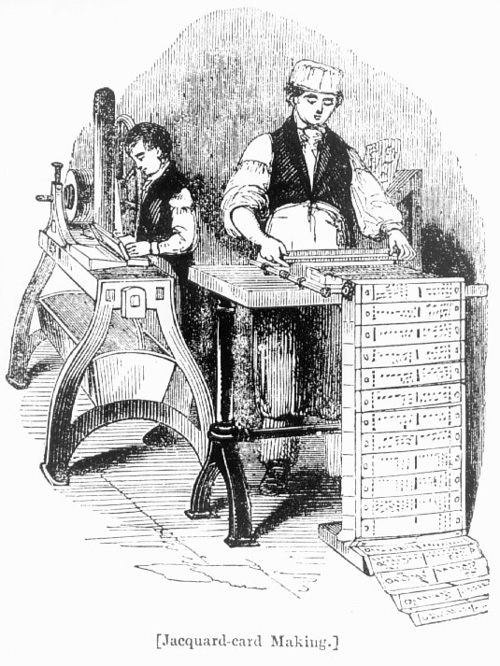
Making the Cards for the Jacquard Loom
Hollerith studied the Jacquard loom, guessing that a similar idea might be used in census work. He realized that the punched cards, with pins passing through the holes and closing electrical contacts which would om turn activate mechanical counters, could be an efficient system for storing information. At first he experimented with paper tape, but quickly found that the tape had to stop to allow the pins to go through. He then switched to cards. A whole system, for punching the data on cards, and for sorting and reading the cards, was eventually built: the Hollerith Electric Tabulating System. "Hollerith's system was first tested on tabulating mortality statistics in Baltimore, New Jersey in 1887 and again in New York City. [ … ] Everything was in place by June 1890 and the first data from the census arrived in September of that year. The counting was completed by 12 December 1890 having taken about three months to process instead of the expected time of two years if counting had been done by hand [ … ] The cost of the census tabulation was 98% higher than the previous one, in part because of the temptation to use the machines to the fullest and tabulate more data than formerly possible, but the tabulation was completed in a much shorter time. [ … ] Speed was not the only benefit of using Hollerith's system. It was possible to gather more data, and data such as the number of children born in a family, the number of children still alive in a family, and the number of people who spoke English were part of the 1890 census." [ from MacTutor ]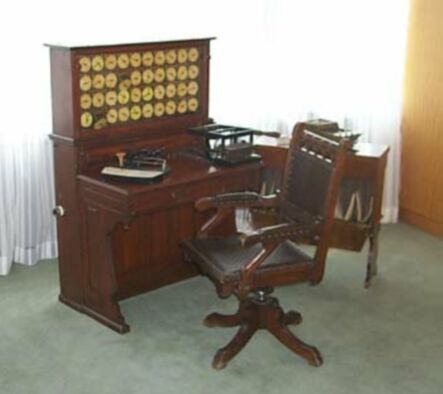
In 1896 Hollerith founded the Tabulating Machine Company, which, after several mergers and acquisitions, in 1924 became IBM. Hollerith continued to perfect his system. "The horizontal units were equipped to sense the hole position in a card by activating a magnet, so that the card, which traveled through the machine on a belt, was steered by a guide channel into a particular pocket. The machine could sort cards into any of 12 pockets. Though crude by comparison, the sorters nevertheless bear a distinct resemblance to those used to sort bank checks today." [ from IBM Archives ]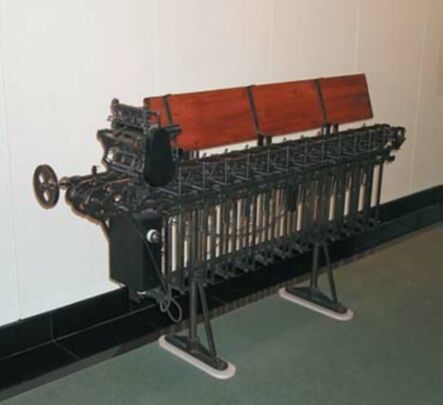
Herman Hollerith's Automatic Sorter
Here is the cover of the August 30, 1890 issue of Scientific American.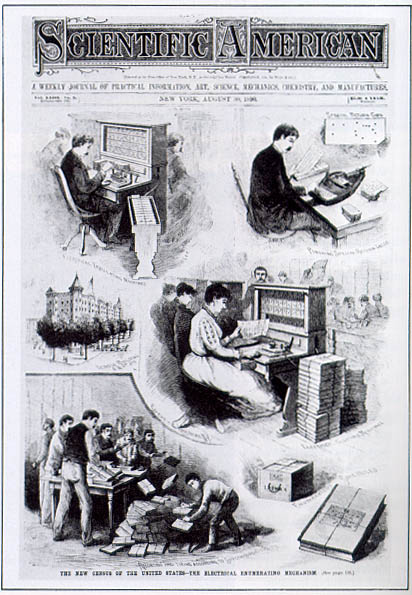
New Census of the United States - The Electrical Enumerating Mechanism
-
Several crucial inventions followed. The first, in 1904 was J. A. Fleming's diode vacuum tube,
followed in 1906 by Lee De Forest's triode vacuum tube. The diode had a filament and a plate, whose original
function was to detect weak radio signals. The triode had a third element, which allowed the tube to amplify signals. See also
The Invention of the Electron Tube.
Triodes then led W H Eccles and F W Jordan to invent in 1919 the first flip-flop circuit design. A flip-flop circuit, also called bistable multivibrator or trigger circuit, is a device in which one of two active components (triodes) conducts, while the other does not, until an appropriate signal is applied. In terms of logic, the flip-flop performs the functions of memory. It is interesting to note that already in 1883 Thomas A Edison, while exploring the new area of commercial electric lighting, had discovered that a tube from which most of the air has been extracted can pass an electric current. However, Edison did not realize that such a device could be used to regulate and control currents."DeForest's triode touched off the first of what has become a steady stream of applications of electronics technology, which have affected the character of twentieth-century life. It transformed the radio industry by making it possible to transmit more powerful signals at higher frequencies than before, and at the receiving end it allowed extremely faint signals to be amplified and thus made intelligible. It transformed the telephone industry by permitting voice signals to be amplified and thus sent across long distances-something that hitherto had been possible only with the dot-dash signals of the telegraph. Each of these advances led in turn to further developments in communication and control. But the calculator and accounting machines industries were not among those so rapidly transformed . One reason was that engineers who worked with the vacuum tube did not perceive it as a switch that could route electrical pulses through a circuit. Indeed, they designed circuits to minimize the tube's tendency to act as a digital switch, while maximizing its ability to produce an amplified, but smooth, continuous copy of its input. The telephone engineer's goal was to get the circuit to reproduce as accurately as possible the nuances of the original signal and to minimize any tendency the tube had to latch on to either extreme of letting all or none of the available current through. Applications requiring all-or-nothing switching, as in routing telephone calls, or transmitting the discrete dots and dashes of Morse telegraph signals, were well served by electromechanical relays. Given these two apparently separate arenas of tube and relay applications, there was a general perception that tubes were ill-suited for calculators, which handled discrete digits and not continuous signals. In the 1930s, relays and mechanical devices still served the calculating machines industry well. These devices permitted rapid calculation compared to manual methods, which satisfied most users (except formen like Wallace Eckert, L. J. Comrie , and Howard Aiken who wanted to use these machine to solve highly complex scientific problems) . Furthermore, electromechanical calculating speeds were in balance with the speeds of the other activities like recording and reading data, and directing the sequence of calculations: activities still done by hand. The limits of the relay's speed to a few arithmetic operations a second did not form a bottleneck that machine designers were concerned with breaking. It was not until the mid-1930s that anyone began to think seriously of using high-speed electronic circuits in digital calculating machinery. " [from chapter 7 of William Aspray et al.'s Computing Before Computers ]
-
Various machines and devices were developed in the twenties and thirties. See references in the Readings, Resources and Questions
section below. Here I will just mention the IBM 601 Multiplying Punch, introduced in 1931. This machine
"read two factors up to eight decimal digits in length from a card and punched their product onto a blank field of the
same card. It could subtract and add as well as multiply [in 1 second]. It had no printing capacity, so was generally used as an offline
assistant for a tabulator or accounting machine. The 601 that was delivered to Eckert's lab in 1933 was a special model 'capable
of doing direct interpolation,' a very unusual feature, especially designed for Eckert by one of IBM's top engineers at Endicott, NY."
[ from A Chronological History of Computing at Columbia University ]
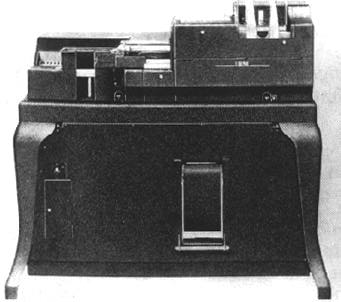
The IBM 601 Multiplying Punch
Readings, Resources and Questions
- A good timeline for the more recent history of computers is Mark Brader's A Chronology of Digital Computing Machines (to 1952) (now maintained by Clive Feather). This page also includes several good references. Another interesting site is The History of Computing Project. See also Timeline of Computing, which is part of the 4th edition of the Encyclopedia of Computer Science. Very interesting are the IBM Archives, where you can find a veritable museum of computing, covering much more than the company's history, and A Chronological History of Computing at Columbia University. Of more specific interest is the Vintage Calculators Web Museum.
- As illustrated in the quotation from Aspray et al's Computing Before Computers above, it often takes time before the full range of applicability of certain inventions is explored and utilized. Find and discuss other examples.
© Copyright Luigi M Bianchi 2001, 2002, 2003
Picture Credits: THOCP · Virginia Tech · IBM Archives · NYU · Columbia U
Last Modification Date: 11 April 2003
Picture Credits: THOCP · Virginia Tech · IBM Archives · NYU · Columbia U
Last Modification Date: 11 April 2003